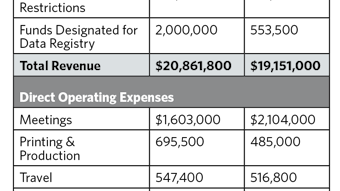How to write a business plan
Many years ago, one of the authors came across the book, Handbook of Law Firm Mismanagement, a tongue-firmly-in-cheek exposé on the business of a learned profession.
By Brian J. McKinnon, MD, MBA; Selena Heman-Ackah, MD, PhD, MBA; Ken Kazahaya, MD, MBA; and C. Anthony Hughes, MD, MBA, MPH

One key business activity is the preparation of a business plan. Writing a business plan provides a process to assess the viability of a potential new service or product, or expansion of a current service. A well-written business plan may also help guide a company after its launch, especially if the direction becomes unclear. During the AAO-HNS/F 2016 Leadership Forum & BOG Spring Meeting, we introduced the audience to the process of developing a business plan, using their formal business education and personal experiences in the public and private sector.
The groundwork for a business plan includes an in-depth evaluation of an opportunity or concern the project is to address—identifying stakeholders, assessing the impact of the opportunity or concern on each stakeholder, and the manifestations of the opportunity or concern. Any previous attempts at addressing the opportunity or challenge should be reviewed for lessons learned. Evaluation of organizational resources will reveal what is available internally, and what may be needed externally to address the opportunity or concern.
Assessment of the organization’s strengths and weaknesses in regard to its ability to be effective or take advantage of a particular opportunity is of central importance. This is often referred to as a SWOT analysis, an acronym referring to its four components: strengths, weakness, opportunity, and threats. While seeming simplistic, this analysis requires objective, often brutal honesty. When done well it will markedly improve the quality of the business plan, and the likelihood of success.
Elements of a business plan typically include: the Executive Summary, company description, organizational structure, product details, market analysis, marketing/sales strategy, and financials/funding. The Executive Summary, written last, should include a mission statement, experience/background of the key individuals, summaries of market analysis, target market, and future plans. The company description and organizational structure provides a clear picture of the company’s abilities and weakness, helps organize information, and provides an accurate assessment of the company’s ability to take advantage of an opportunity and/or effectively counter a threat. Product details and market/sales analysis and strategy provide the background for the need or desire for a product or service, and the likelihood that an action will succeed in achieving the desired results. Growth strategy and funding/financials provide for planning the monetary needs that will be demanded to achieve the proposed plan.
Presenting and executing the plan is the culmination of the research and writing of the plan. The “elevator pitch” is the succinct telling of the business plan’s key elements, why it is important, and how the listener can contribute. The written plan should be professional, typed, and edited. A cover letter should be included, giving readers a very concise picture of the proposal and why they should support your plan. The goal is to interest and inspire, with the hope of gaining the opportunity of a more detailed presentation. Executing the plan is a cyclical process, requiring the stakeholder to engage in a constant and active process of re-evaluation to incorporate lessons learned and ensure that the goals of the business plan remain achievable and rewarding.
The writing of the business plan does take time and patience to learn; learning to do so effectively will go a long way toward improving our care and our profession.


















